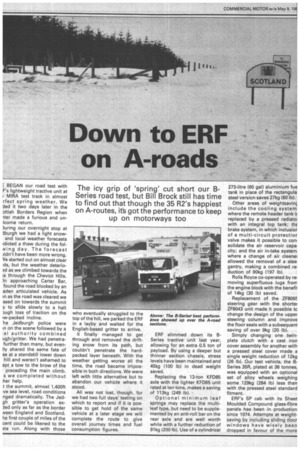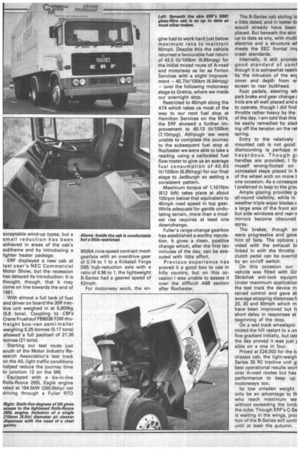Down to ERF on A-roads
Page 46

Page 47

If you've noticed an error in this article please click here to report it so we can fix it.
The icy grip of 'spring' cut short our BSeries road test, but Bill Brock still has time to find out that though the 35 R2's happiest on A-routes, it's got the performance to keep up on motorways too
E BEGAN our road test with F's lightweight tractive unit at MIRA test track in almost rfect spring weather. We Jed it two days later in the 3ttish Borders Region when iter made a furious and unlcome return.
)uring our overnight stop at iburgh we had a light snow and local weather forecasts !dieted a thaw during the folsing day. The forecast ildn't have been more wrong. Ve started out on almost clear ds, but the weather deterioad as we climbed towards the ;s through the Cheviot Hills. )n approaching Carter Bar, found the road blocked by an aden articulated vehicle. As in as the road was cleared we ssed on towards the summit y to slide slowly to a halt Righ loss of traction on the iw-packed incline.
he Jedburgh police were In on the scene followed by a :al authority combined ugh/gritter. We had penetra further than many, but evenIly shared the same fate of se at a standstill lower down hill and weren't ashamed to ept a tow to the brow of the preceding the main climb.
s we completed without her help.
t the summit, almost 1,400ft ve sea level, road conditions nged dramatically. The Jedgh gritter's operation exJed only as far as the border Neen England and Scotland. he first couple of miles of the cent could be likened to the sta run. Along with those who eventually struggled to the top of the hill, we parked the ERF in a layby and waited for the English-based gritter to arrive.
It finally managed to get through and removed the drifting snow from its path, but couldn't penetrate the hardpacked layer beneath. With the weather getting worse all the time, the road became impossible in both directions. We were left with little alternative but to abandon our vehicle where it stood.
All was not lost, though, for we had two full days' testing on which to report and if it is possible to get hold of the same vehicle at a later stage we will complete the route to give overall journey times and fuel consumption figures. ERF slimmed down its BSeries tractive unit last year, allowing for an extra 0.5 ton of payload. By using a deeper but thinner section chassis, stress levels have been maintained and 46kg (100 lb) in dead weight saved.
Replacing the 13-ton KFD85 axle with the lighter KFD65 unit rated at ten tons, makes a saving of 113kg (249 lb).
Optional minimum leaf springs may replace the multileaf type, but need to be supplemented by an anti-roll bar on the rear axle and are well worth while with a further reduction of 91kg (200 lb). Use of a cylindrical 273-litre (60 gal) aluminium foe tank in place of the rectangula steel version saves 27kg (60 lb).
Other areas of weightsavinc include the cooling system where the remote header tank i; replaced by a pressed radiatoi with an integral top tank; thE brake system, in which inclusior of a multi-circuit protectior valve makes it possible to con. solidate the air reservoir capa. city; and the air in-take system where a change of air cleanei allowed the removal of a stee gantry, making a combined re. duction of 90kg (197 lb).
Rolls Royce co-operated by re. moving superfluous lugs frorr the engine block with the benefil of 14kg (30 lb) saved.
Replacement of the ZF806E. steering gear with the shorter ZF8043 unit made it possible tc change the design of the upper steering column and improve the floor seals with a subsequen1 saving of over 9kg (20 lb).
Simply changing one twinplate clutch with a cast iron cover assembly for another with a pressed steel cover made a single weight reduction of 12kg (26 lb). Our test vehicle, the BSeries 35R, plated at 36 tonnes, was equipped with an optional set of alloy wheels weighing some 129kg (284 lb) less than with the pressed steel standard fitment.
ERF's SP cab with its Sheet Moulded Compound glass-fibre panels has been in production since 1974. Attempts at weightsaving by including sliding door windows have wisely been dropped in favour of the more acceptable wind-up types, but a small reduction has been achieved in areas of the cab's subframe and by introducing a lighter heater package.
ERF displayed a new cab at last year's NEC Commercial Motor Show, but the recession has delayed its introduction. It is thought, though, that it may come on line towards the end of 1981.
With almost a full tank of fuel and driver on boardthe 35R tractive unit weighed in at 5,900kg (5.8 tons). Coupling to CM's Crane Fruehauf F88038 F2M drufreight box-van semi-trailer weighing 5.25 tonnes (5.17 tons) allowed a full payload of 21.36 tonnes (21 tons).
Starting our test route just south of the Motor Industry Research Association's test track on the A5, light traffic conditions helped reduce the journey time to junction 12 on the M6.
Equipped with a six-in-line Rolls-Royce 265L Eagle engine rated at 194.5kW (260.8bhp) net driving through a Fuller RTO 9509A nine-speed contract mesh gearbox with an overdrive gear of 0.74 to 1 to a Kirkstall Forge D65 hub-reduction axle with a ratio of 4.96 to 1, the lightweight B-Series had a geared speed of 62mph.
For motorway work, the en gine had to work hard just below maximum revs to maintain 60mph. Despite this the vehicle returned a favourable fuel return of 42.5 lit/100km (6.65mpg) for the initial mixed route of A-road and motorway as far as Forton Services with a slight improvement — 40.711t/100km (6.94mpg) — over the following motorway stage to Gretna, where we made our overnight stop.
Restricted to 40mph along the A74 which takes us most of the way to our next fuel stop at Hamilton Services on the M74, the ERF showed a further improvement to 40.13 lit/100km (7.10mpg). Although we were unable to complete the journey to the subsequent fuel stop at Rochester we were able to take a reading using a calibrated fuel flow meter to give us an average fuel consumption of 40.65 lit/100km (6.95mpg) for our final stage to Jedburgh so setting a consistent pattern.
Maximum torque of 1,101Nm (812 lbft) takes place at about 100rpm below that equivalent to 40mph road speed in top gear. While adequate for gentle undulating terrain, more than a modest rise requires at least one downchange.
Fuller's range-change gearbox has established a worthy reputation. It gives a clean, positive change which, after the first ten minutes of the day, can be executed with little effort.
Previous experience has proved it a good box to use in hilly country, but on this occasion I was unable to assess it over the difficult A68 section after Rochester. The B-Series cab styling lo a little dated, and in better tir would already have been placed. But beneath the skin up to date as any, with multi. electrics and a structure wi meets the EEC frontal irriF crash standards.
Internally, it still provide good standard of comf though it is somewhat restrir by the intrusion of the enç cover and depth from wi screen to rear bulkhead.
Foot pedals, steering wh park brake and gear change trols are all well placed and e to operate, though I did find throttle rather heavy by the of the day. I am told that this be easily remedied by sled, ing off the tension on the ret spring.
Entry to the relatively mounted cab is not good dismounting is perhaps re hazardous. Though gi handles are provided, I fa myself wrong-footed on concealed steps placed in fr of the wheel arch on more t one occasion. As a conseque I preferred to leap to the groL Ample glazing provides gi all-round visibility, while in weather triple wiper blades c a large area of the front scr but side windows and rear-v mirrors become obscured spray.
The brakes, though srt were progressive and gave hint of fade. The options vided with the exhaust be linked in with the throttle clutch pedal can be overrid by an on/off switch.
On this occasion our vehicle was fitted with Gir Skidchek anti-lock equipm Under maximum application the test track the device m tamed control and gave aL average stopping distances ft 20, 30 and 40mph which m have been improved but ft short delay in responses at beginning of the stop.
On a wet track wheelspin tricted the hill restart to a on five gradient initially, but late the day proved it was just r sible on a one in four.
Priced at £24,000 for the b. chassis cab, the light-weigh Series 35 R2 tractive unit gi best operational results worl over A-road routes but has performance to keep up motorways too.
Its low unladen weight only be an advantage to th who reach maximum we without exceeding the limit: the cube. Though ERF's C-Se is waiting in the wings, pro( tion of the B-Series will conti until at least the autumn.
































































































































































